February has been an unusual month for us. The weathermen told us that the tail end of the storm that passed over Eastern USA, affected our weather also. The result of it was a drop in temperature and a lot of rain. The fields on the back of our land once again looked like a lake as the river Seudre broke its banks.
On our side we have a slight mound that protects our land and of course the beehives.
Some days I definitely feel the cold of the late winter, but on other days I get the impression that the spring has once again returned. Our next door neighbour, Jean-Marie, has kept a few sheep and one has produced a twin and that has added extra excitement for us.
I must confess that I have been like a father expecting the arrival of our first child. I have been perhaps over anxious wanting to open up the beehives and have a proper look inside. Certainly during the warm parts of each day, the girls have been busy coming and going and bringing loads of pollen. Passing underneath our plum tree you can hear the symphony of bees as they move from one blossom to the other. Our salix caprea or goat willow, or as it is know here saule marsault, near the river is quite big and its yellow catkins are opening and attracting the bees. Less than a couple of hundred metres away a field of rape is beginning to flower. The net results, as you see, is great activity at the hive entrance.
Amelia and I had a management committee meeting and made a few decisions. First step was to remove the empty supers that we had placed under each hive to raise the brood box away from the ground. That was based on the recommendations made by the late Brother Adam of the Buckfast Abbey. We also used the opportunity to remove the screened bottom boards and cleaned them with washing soda solution. There was not a lot of debris present.
A couple of days later when the temperature had reached around 14C (58F), we decided to open up the hives one by one. The main reason for that was that the previous day we had noticed a large number of bees flying around the entrance of each hive. This looked as if the newly hatched bees were taking their flight of orientation, which meant that the eggs their queens had laid around Christmas must have resulted in new bees emerging from their hives.
Last November we had put partitions in three of our four hives. So, if there were new bees, the bees might need more frames for brood and food storage.
Our youngest colony, Sunflower, had two partitions on either side, but the remaining seven frames were full of bees. In autumn we had not removed any frame from Cornucopia, but the other two, Poppy and Violette were similar to Sunflower. The frames inside the partitioned areas were full of bees.
We removed the partitions to give room to the colonies to expand. We did not wish to disturb the bees any more that day. So we waited another few days until 26th February 2016, for the full inspection.
The frames with honey on the sides were full of bees and a noticeable quantity of yellow pollen stored.
We saw what we had hoped to see, that is fairly large area of brood cells as well as larvae.
Cornucopia, our first swarm of 2015 had 6 frames with brood on either side and four frames heavily laden with honey. The only little concern was that we found what appeared to us to be one queen cell on frame 7.
Looking up on the internet, I am lead to believe from FERA that there are 3 distinct type of queen cells, namely swarm cells; supersedure cells; and emergency cells. Ours appear to me to be a supersedure cell and if so the recommendation is not to destroy it and let the bees sort it out for themselves. Naturally I would welcome any comment.
One brood arrangement looked to be almost the shape of a bee.
I have been told that usually when bees fly out, they either bring in nectar or pollen, but not both. As we upturned the inner cover with a partially eaten candy on top, this little bee came hungrily sucking up some syrup that had oozed out. But she was already laden with pollen!
Violette is definitely Amelia’s favourite hive. She was therefore delighted that when we opened her she could see Her Majesty. The queen just wandered calmly around the brood cells. I myself was amazed watching how much pollen they had collected.
Having seen the colonies, and especially seeing how full Cornucopia was, we decided that there is so much pollen and nectar around us that we must give more room to Cornucopia. I was also remembering that the queen cell we had noticed in Cornucopia, and I felt that it is again as good a time as any to give extra room to the colony. The bees certainly were finding every flower in the garden. This one was busy on the camelia that has just started flowering.
On 29th February we placed our first super on Cornucopia with fresh frames. We placed empty supers on the other hives to save us time for the future. Hopefully in 2 to 3 weeks we will examine those hives and see if they are ready to accept fresh frames for collecting the spring honey.
Kourosh


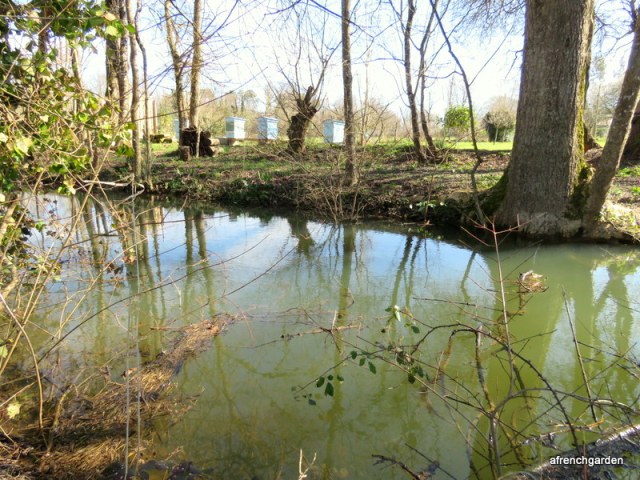
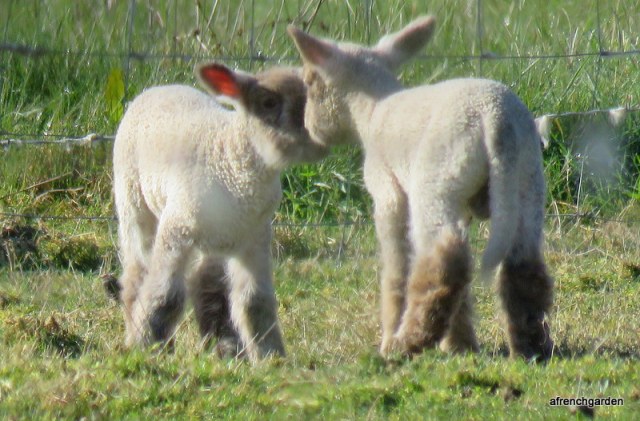
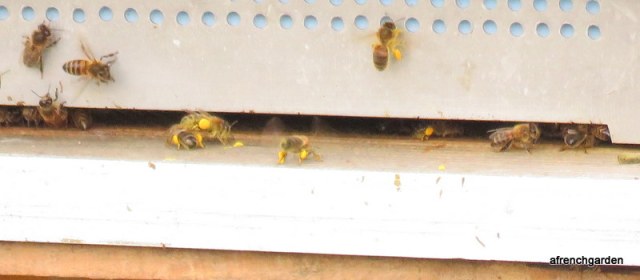

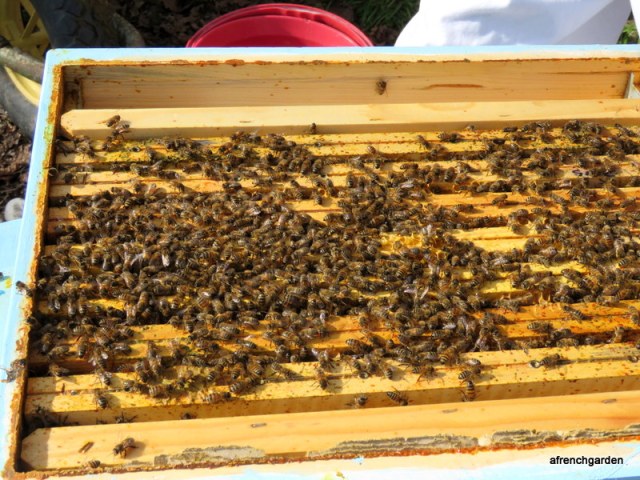
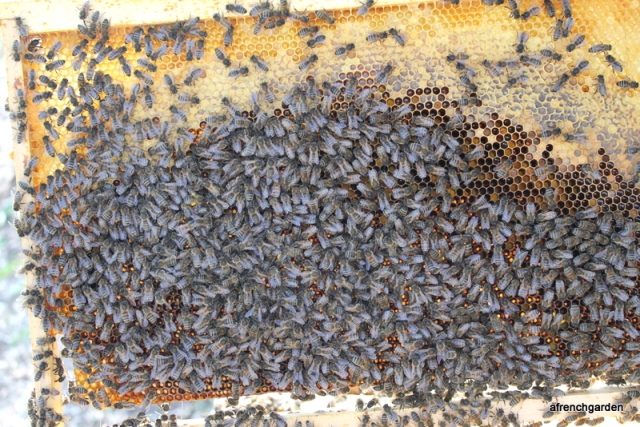


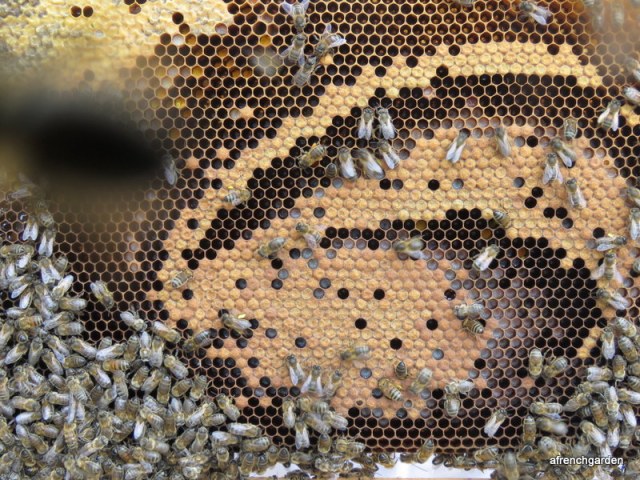

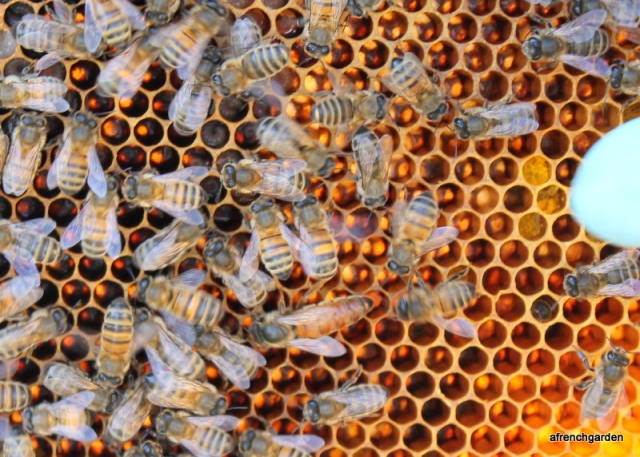

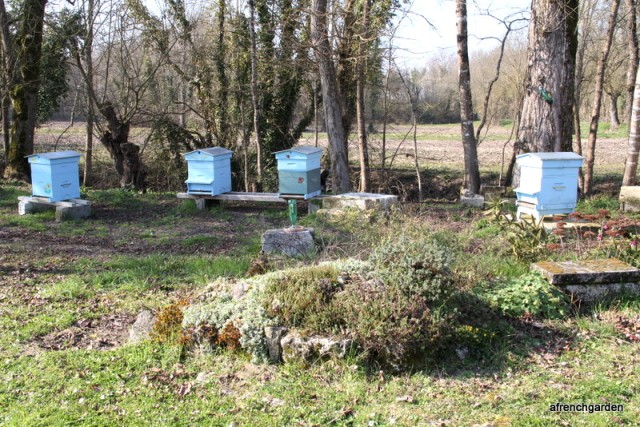
I respect the wisdom, kindness and lore of beekeeping even though I don’t understand the details. Thanks for sharing these wonderful pictures.
LikeLiked by 1 person
Thank you Susan for your kind comments. This is our first year that we have kept bees and we have learnt a great deal. We have no intention of selling honey, nevertheless in the autumn we produced more than plenty to share with all our neighbours and friends. Although this is really my wife’s gardening blog, I will from time to time attempt to make some small contributions. – Kourosh
LikeLiked by 1 person
… and large contributions to the gardens of your neighbours, via your bees.
LikeLiked by 1 person
I hope so.
My neighbour, Jean-Marie grew up in this village and his father used to keep bees, but not in this area. Jean-Marie was delighted when I presented him with our first honey, as for him this was a continuity that he had hoped for. – Kourosh
LikeLiked by 1 person
What a beautiful sight! In the photo where you say the brood looks like a bee I can just imagine the queen walking that arc laying eggs as she goes.
LikeLiked by 1 person
Thank you, Mark. All I can assume is that as the new bees emerge from some cells we will notice the empty spaces. Also the bees leave some empty cells deliberately in the middle of the brood area for the nurse bees to enter warming the brood. So, we do get strange shapes from time to time. Isn’t nature wonderful? – Kourosh
LikeLiked by 1 person
What an education you are giving me. Thank you.
LikeLiked by 1 person
Thank you, John. This last year I have enjoyed working with bees and getting to know them a little better. Like all hobbyists, it is wonderful for me to be able to share my experience with you, through Amelia’s blog. I will try not to bore everyone too often – that is a promise! – Kourosh
LikeLiked by 1 person
Not a bore. Keep it coming.
LikeLiked by 1 person
Thank you. You are a gentleman. – Kourosh
LikeLiked by 1 person
Very nice writeup.
LikeLiked by 1 person
Many thanks – Kourosh
LikeLike
Since our winter was a total bee loss, I’m in awe. Maybe next spring we will have a beautiful spring inspection like yours. Congratulations.
LikeLiked by 1 person
Many thanks for your encouragement. I am keeping my fingers crossed and hope that the so-called beginner’s luck will hold for us. I just heard that our teacher from the bee school that we attended all last year, has lost all his bees. He had over fifty hives. I am sure that it must have been a mixture of many factors.
I do hope that your ‘girls’ also behave (or should I say beehive) themselves. Good luck – Kourosh
LikeLiked by 1 person
Lovely post Kourosh, I do not really understand about the queen cell on frame 7, does that mean a second queen?
LikeLiked by 1 person
The biologists call the bee colony a super organism. They have complicated behaviours. If the colony senses that the queen is not doing a good job – in other words not laying enough eggs, perhaps because she was not well fertilised, or she might be getting old, then they do make a new queen cells and start feeding one or more eggs exclusively with royal jelly to make that into a new queen. Sometimes in her daily inspection, if the old queen finds such cells, she destroys it. Other times the new queen is born and the two ladies either fight it out or one – normally the old queen – just leaves as a swarm with about half the colony. The newly emerged queen then has to start laying eggs after her one and only nuptial flight.
The problem is that during winter all male bees die. So at this time of the year there are no males in the region to fertilise the virgin queen.
So for now I just let nature take its own course.
– Kourosh
LikeLiked by 1 person
Thank you for explaining, I can imagine how fascinating it must be to watch your bees.
LikeLiked by 1 person
It looks like a supersedure cell in Cornucopia to me too. I am surprised that they would be superseding so early in the season though – are there drones around for a new queen to mate with? You have a lovely amount of brood in there, did you see eggs as well as capped/uncapped brood? Great to see the colonies doing so well.
LikeLiked by 1 person
Thank you, Emily for the comment. I agree with you that it is too early for having any drones to fertilise any emerging queen.
I did see eggs and larvae when I inspected the hives, and I was certainly pleased with the amount of brood as well as honey and pollen stored. HOWEVER, I am quite worried as I just heard that our teacher from the bee school that Amelia and I attended all last year, has lost all his bees. He had more than fifty hives. Our friend Michel has also just lost most of his hives. Nobody is sure of the reason(s).
I am just hoping that our beginner’s luck will hold.
Amelia and I were away for two weeks. Our bees have been quite busy since our return home yesterday. But I am hoping to do another thorough inspection in the next few days.
I hope your ladies also do well. – Kourosh
LikeLike
Hi Kourosh, good that you saw eggs, so you have a laying queen. I noticed that in your reply to Laura you said you didn’t see inside the queen cell, so perhaps it is an old one or they are just getting it ready for future mischief 🙂 Will be interesting to see what you find next.
Very sad about your teacher and friend losing so many hives all at once. They must be feeling devastated. Sometimes it can be very hard to work out why and perhaps all sorts of factors are contributing, the bees face so many challenges now – varroa, nosema, lack of forage, the changing climate and of course you have asian hornets too.
LikeLiked by 1 person
I was so saddened to read ‘the decay of spring’ and the loss of Pepper. We all look after our bees and I find myself so attached to each of them. Sometimes Amelia or I have found a bee cold and on her side in front of the hive. We bring her inside in the palm of our hand and give her a bit of honey and warmth and as she starts moving around, we take her back to her hive.
It is so hard not to become a bit sentimentalist. I wish you and Emma good luck. – Kourosh
LikeLike
Thanks Kourosh. We also like to warm cold bees in our hands, blowing hot air gently on them to restore them to life. It is a lovely feeling when a bee starts moving again. Every bee is precious.
LikeLiked by 1 person
It looks like you’re going to have a lot of honey!
LikeLiked by 1 person
Thank you. We have no intention of selling honey but hope that we can produce just enough to share with family and friends. – Kourosh
LikeLiked by 1 person
Heart warming. I love to see your bees.
LikeLiked by 1 person
Thank you. If you like seeing them, then you must come over for a visit. We would enjoy your company. – Kourosh
LikeLiked by 1 person
Well done, you are doing very well with your hives. I know it isn’t as easy as some may think.
LikeLiked by 1 person
Thank you, Christina. Like having children, one has many joyful moments and some worrying periods. – Kourosh
LikeLiked by 1 person
Did you look inside the queen cell? Did it have a larvae and royal jelly or was it dry? Many hives keep a dry queen cell or 2 around just in case. That way if their queen fails them, they can quickly move and egg in and make a new queen.
If the cell has anything in it, you likely will have either a supersedure or a swarm (I know swarm cells should be on the bottom of the frames, but nothing is ever “always” when it comes to bees).
Looking at that lovely brood next, I’d be very surprised if your colony decided this was a good time to replace their queen – she’s doing a great job!
For the record, I never remove queen cells of any kind. The few times I’ve been convinced to try, I end up with swarms anyway. Once bees decide to make a new queen, it’s nigh on impossible to stop them. So my advice is whether the cell has a baby queen or nothing in it, it’s best to leave it for the colony to deal with.
LikeLiked by 1 person
I should probably point out that by “look inside” the queen cell I am assuming it is uncapped and you can tip the frame up and look at what’s in the cell. If it’s capped, it definitely has a baby queen and you will have to wait to see if she’s a good one.
LikeLiked by 1 person
Many thanks, Laura. I agree entirely with your comments and advice.
We, too were pleased with the amount of brood as well as honey and pollen stored. We did also see eggs and larvae around the brood area. But I did not look too closely at the queen cell to see what was inside.
Amelia and I have been away for two weeks and have just returned home. So I hope to do a more thorough inspection in the next few days.
As you suggested, we decided to let nature do its own magic for now.
I hope your girls are also behaving themselves.
– Kourosh
LikeLike
My girls are doing really well. Too well. This week we had to buy more buckets. We thought we could leave any surpluss honey in the hives but it is becoming inconvenient – they are building between combs and under the lid and any time we want to inspect we have heavy boxes to move and honey running everywhere. So we bought more buckets. We’ve harvested 800 kg from our hives so far and I suspect we could reach a tonne if we tried. Each of the last two years we’ve barely made 300 kgs from the same apiary. It amazes me how the colonies vary from year to year (and hive to hive).
LikeLiked by 1 person
That is absolutely wonderful news. Keep it up with the bees and keep writing your novels! – Kourosh
LikeLike
Brother Adam was such a source of knowledge about beekeeping. An interesting post and link to a very informative website.
LikeLiked by 1 person
Thanks. Brother Adam was certainly my hero.
Here in France the information about bees is not always precise enough for my liking, so I also follow the advice given by the Belgian as well as UK authorities. At the end, however, one thing I have learnt is that although we read all the books, the bees do not read the books and do their own things. So, to some extend I believe that the colony knows best, and although I am happy to give them some encouragement, I leave them to do what they like to do. – Kourosh
LikeLike
So glad the bees survived winter and did so well.
LikeLiked by 1 person
Thanks, Marie, for your encouragement. There are still many perils and pitfalls, but so far so good and I try to remain optimistic. – Kourosh
LikeLike
Pingback: A swarm in April can change its mind | a french garden